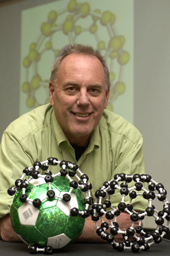| Chris Toumey |
|
Nanotechnology gains much attention and credibility from a portfolio of detailed and attractive images of atoms, molecules, and other nanoscale objects. Usually they are created by either a Scanning Tunneling Microscope (STM) or an Atomic Force Microscope (AFM). These images employ familiar conventions for making the nanoscale look like a three-dimensional topography. Yet there is a series of problems in the relation between a nanoscale object and a picture of the object. Nanoscale objects are much smaller than the wavelength of visible light, in which case colors, shading and other visual conventions are artificial. A picture of an atom or a molecule cannot possibly look like an atom or a molecule. This relationship has been explored extensively by philosophers, artists and others. Now, in addition to seeing what is wrong with nano images, we should also see what is right: what is the visual knowledge in these images that is worth appreciating? To answer that question, we can turn to certain aesthetic resources, e.g., the cubist principle of simultaneité. And then simultaneité leads to an exercise called inter-instrumentality. By employing these aesthetic resources, we can derive visual knowledge from nano images even as we realize the problems in the relation between a molecule and a picture of a molecule.
Chris Toumey is a cultural anthropologist who works in the anthropology of science. He received his Ph.D. from the University of North Carolina in 1987 and is currently a researcher in the University of South Carolina NanoCenter. Since 2003 he has focused on societal and cultural issues in nanotechnology, including the narratives of the origins of nanotechnology, the question of democratizing nanotech, and problems and solutions regarding images of nanoscale objects. His current research concerns religious reactions to nanotechnology. His publications include Conjuring Science: Scientific Symbols and Cultural Meanings in American Life (Rutgers University Press, 1996) and he regularly contributes to the journal Nature Nanotechnology. |


